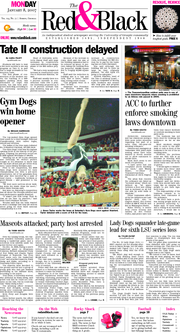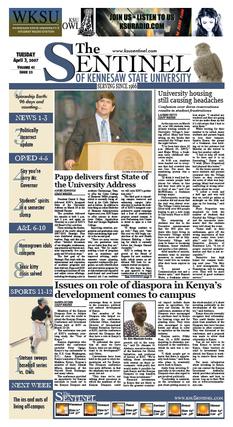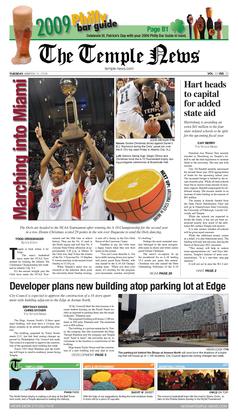Related Research Articles

Boston College (BC) is a private Jesuit research university in Chestnut Hill, Massachusetts. Founded in 1863, the university has more than 15,000 total students. Although Boston College is classified as a research university, it still uses the word "college" in its name to reflect its historical position as a small liberal arts college.

The Daily of the University of Washington, usually referred to in Seattle simply as The Daily, is the student newspaper of the University of Washington in Seattle, Washington, USA. It is staffed entirely by University of Washington students, excluding the publisher, advertising adviser, accounting staff, and delivery staff.
The Rice Thresher is the weekly student newspaper of Rice University in Houston, Texas. It was first published in 1916. It has an estimated circulation of 3,000 and is distributed throughout the university and its surrounding areas.

The Maneater is the official, editorially independent student news publication of the University of Missouri. The Maneater editorial and advertising staffs are composed entirely of students, with the exception of a professional business adviser. Financially, The Maneater is a non-profit publication funded by advertisers. The newspaper is distributed free of charge, and all aspects of its website remain accessible at no cost to readers. The editorial department of The Maneater remains independent from any student governments and organizations, as well as the Missouri School of Journalism and university itself.
The Minnesota Daily is the campus newspaper of the University of Minnesota, published Monday and Thursday while school is in session, and published weekly on Wednesdays during summer sessions. Published since 1900, the paper is currently the largest student-run and student-written newspaper in the United States and the largest paper in the state of Minnesota behind the Minneapolis Star Tribune and the St. Paul Pioneer Press. The Daily was named best daily college newspaper in the United States in 2009 and 2010 by the Society of Professional Journalists. The paper is independent from the University, but receives $500,000 worth of student service fees funding.

The Tulane Hullabaloo is the weekly student-run newspaper of Tulane University in New Orleans, Louisiana. As of 2023 Gabi Liebeler serves as 119th Editor-in-Chief. The Tulane Hullabaloo is also self-funded by selling advertisements to business owners and other organizations on the self-serve advertising platform. The Tulane Hullabaloo publishes its print edition once a month. It has received multiple Pacemaker Awards, the highest award in college journalism.
The College Heights Herald is the student newspaper of Western Kentucky University in Bowling Green, Kentucky, United States. It is free and distributed throughout the campus and city. The school provides professional staff support and facilities for the newspaper but does not exercise editorial control. Called the Herald or the WKU Herald for short, the publication is supported through the sale of advertising and is entirely student-run.
The Daily Bruin is the student newspaper at the University of California, Los Angeles. It began publishing in 1919, the year UCLA was founded.
The Battalion is the student newspaper of Texas A&M University. Started in 1893 as a monthly publication, it continues to this day, now as a weekly print and daily online paper. The Battalion is entirely student-run and covers the university and surrounding Bryan-College Station area.
The Daily Trojan, or "DT," is the student newspaper of the University of Southern California. The newspaper is a forum for student expression and is written, edited, and managed by university students. The paper is intended to inform USC students, faculty, and staff on the latest news and provide opinion and entertainment. Student writers, editors, photographers and artists can develop their talents and air their opinions while providing a service to the campus community through the Daily Trojan. Readers can interact with the Daily Trojan by commenting on social media posts or writing a letter to the editor.

The Red & Black is an independent weekly student newspaper serving the University of Georgia (UGA), updated daily on its website.

The Daily Tar Heel (DTH) is the independent student newspaper of the University of North Carolina at Chapel Hill. It was founded on February 23, 1893, and became a daily newspaper in 1929. The paper places a focus on university news and sports, but it also includes heavy coverage of Orange County and North Carolina. In 2016, the paper moved from five days a week in print to four, cutting the Tuesday edition. In 2017, the paper began to print on only Monday, Wednesday, and Friday. In 2021, the paper began to print only on Wednesdays. All editorial content is overseen by student editors and a volunteer student staff of about 230 people. It's located at 109 E. Franklin St. in Chapel Hill, North Carolina, and it is the largest news organization in Orange County.
The Old Gold & Black is the student-run newspaper of Wake Forest University, named after the school's colors. The newspaper was founded in 1916 and is published in print every other Thursday, with the exception of school holidays and exam weeks. The Old Gold & Black's office is located on the fifth floor of the Benson University Center on Wake Forest's main campus.

Student Life (StudLife) is the independent student-run newspaper of Washington University in St. Louis. It was founded in 1878 and incorporated in 1999. It is published by the Washington University Student Media, Inc. and is not subject to the approval of the University administration, thus making it an independent student voice.

Flyer News, also known as "fn", is the independent student newspaper of the University of Dayton in Dayton, Ohio. It was first published October 21, 1959 and is now published in print monthly while classes are in session, for a total of nine issues per academic year. Currently, 4,000 copies of each issue are distributed throughout campus. Each issue is typically 12 pages long and includes four sections: news, arts and entertainment, opinions and sports. Flyer News' website is updating weekly with campus, local and national news; editorials, Flyer sports recaps and breaking news.

The Sentinel is the official student newspaper of the Kennesaw State University in Kennesaw, Georgia. As of the Fall semester of 2018, the Sentinel has a weekly circulation between 5,000 and 6,000, distributed to over 30 locations on the Kennesaw State University campus.
The Oakland Post is a weekly newspaper published in Oakland County, Michigan. It is a student-run, independent newspaper serving Oakland University. It is owned by the Oakland Sail, Inc. The current editor-in-chief (EIC) is Autumn Okuszka. Arianna Heyman preceded Okuszka, serving as EIC from spring 2023 through fall 2023. Other EICs included Gabrielle Abdelmessih (2022-2023), Aujenee Hirsch (2018-2019), Shelby Tankersley (2017-2018), Paige Brockway (2016-2017), Kristen Davis, Kaylee Kean, Oona Goodin-Smith (2014-2015),Scott Wolchek (2013-2014), Nichole Seguin, Kay Nguyen and Colleen Miller (2009-2010).

The Temple News (TTN) is the editorially independent weekly newspaper of Temple University. It prints 2,000 copies to be distributed primarily on Temple's Main Campus every other Tuesday. A staff of 35, supported by more than 150 writers, is responsible for designing, reporting and editing the bi-weekly paper. Increasingly, TTN is supplementing its bi-weekly print product with breaking news and online-only content on its web site. In September 2007, TTN launched Broad & Cecil, its own blog community.
The Hawk is the weekly student newspaper of Saint Joseph's University. It appears in print and online and includes News, Opinions, Lifestyle, and Sports sections. Exclusive multimedia content can also be found online.

The Chronicle is a daily student newspaper at Duke University in Durham, North Carolina. It was first published as The Trinity Chronicle on December 19, 1905. Its name was changed to The Chronicle when Trinity College was renamed Duke University following a donation by James Buchanan Duke.
References
- ↑ "About Us".
- ↑ "ACP - Contest Winners". Archived from the original on September 27, 2011. Retrieved October 3, 2013.
- ↑ "ACP - 2015 Online Pacemaker".
- ↑ "The Heights, Volume 1, Number 1 — 19 November 1919 — Boston College Newspapers".
- ↑ "The Heights, Volume II, Number 3 — 15 October 1920 Edition 02 — Boston College Newspapers".
- ↑ "The Heights, Volume XXVIII, Number 24 — 28 March 1947 — Boston College Newspapers".
- ↑ "The Heights, Volume XXX, Number 8 — 12 November 1948 — Boston College Newspapers".
- ↑ "The Heights, Volume XXXIII, Number 11 — 11 January 1952 — Boston College Newspapers".
- ↑ http://media.www.bcheights.com/media/storage/paper144/news/2006/11/16/Features/A.Reason.To.Rally-2462870.shtml%5B%5D
- ↑ https://web.archive.org/web/20221127132308/https://www.bcheights.com/2015/04/30/the-time-is-now-for-a-lgbtq-resource-center/
- ↑ https://web.archive.org/web/20230531234813/https://www.bcheights.com/2020/02/24/bc-should-divest-from-fossil-fuels/
- ↑ https://newspapers.bc.edu/?a=d&d=bcheights20091119.2.9&e=-------en-20--1--txt-txIN-------
- ↑ https://www.bcheights.com/2021/04/26/complaints-sent-to-leahy-and-jesuit-years-prior-to-rape-allegations/
- ↑ "About Us".
- ↑ "The Heights, To Greater Heights". Archived from the original on February 28, 2022.